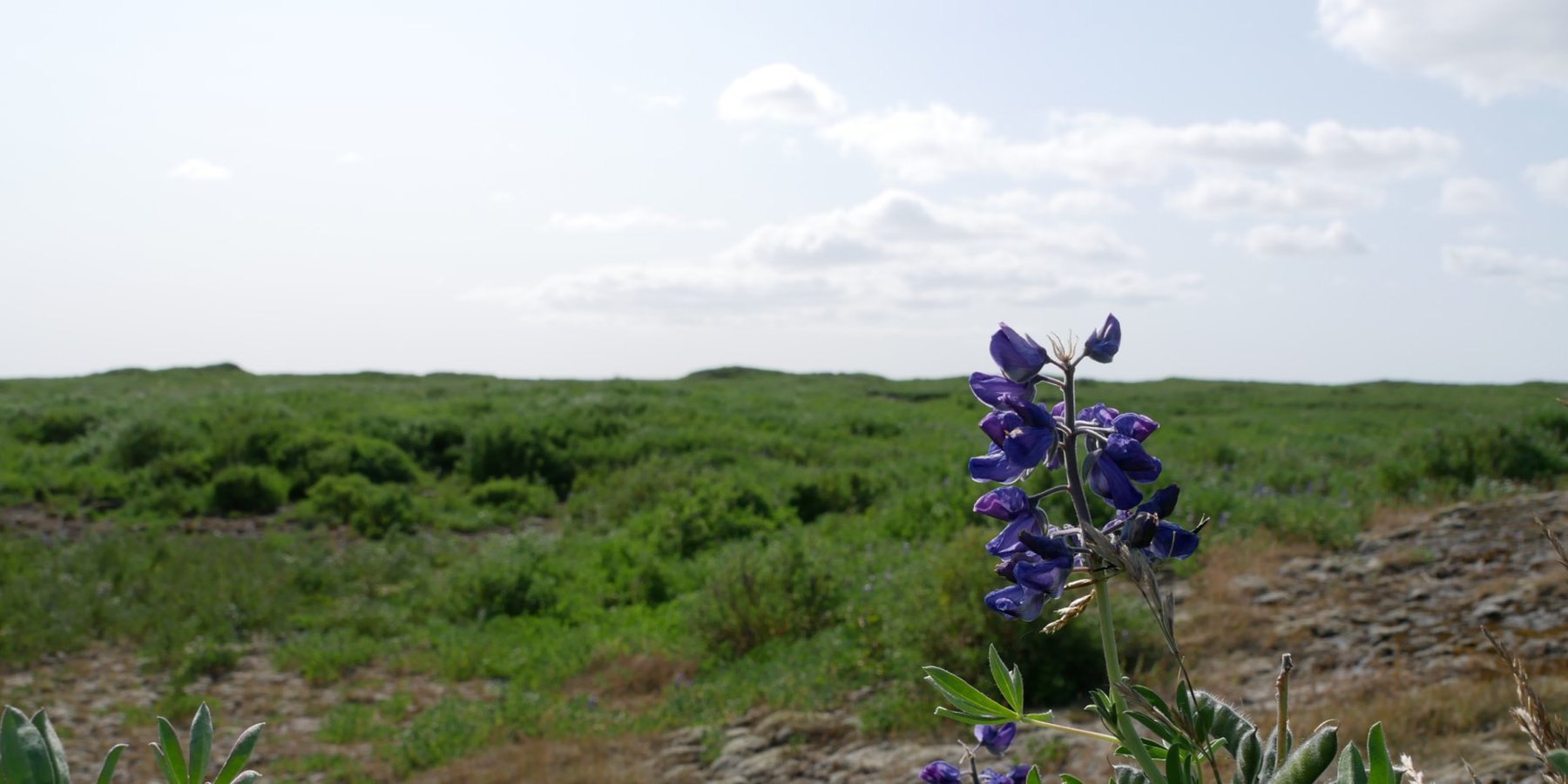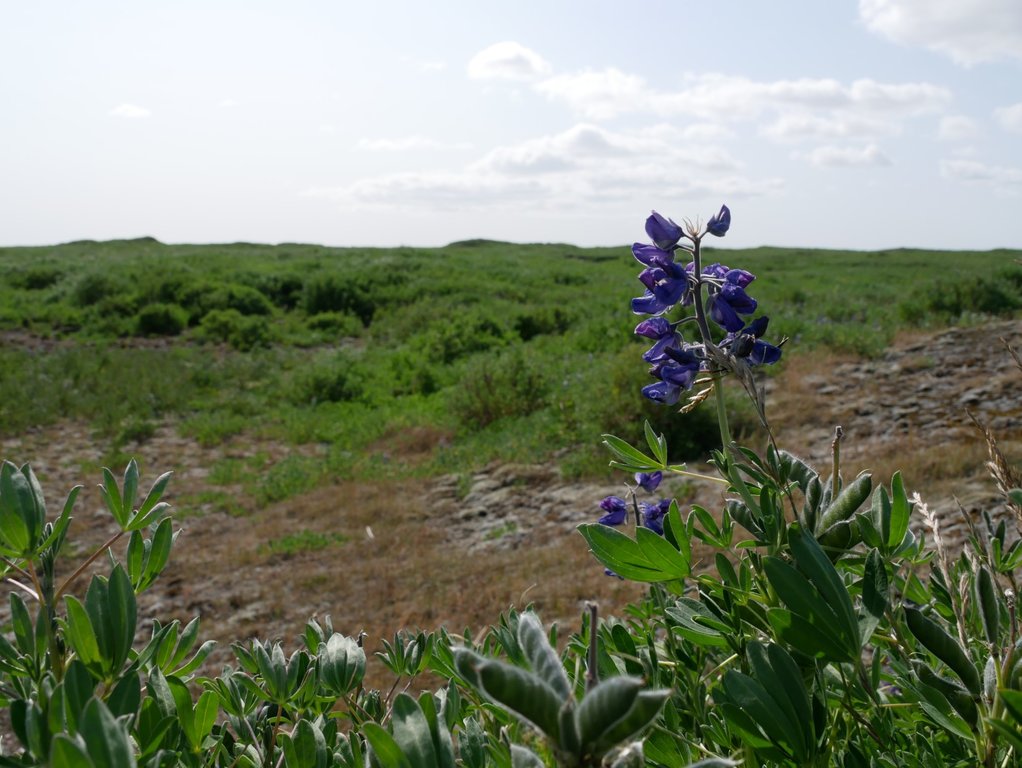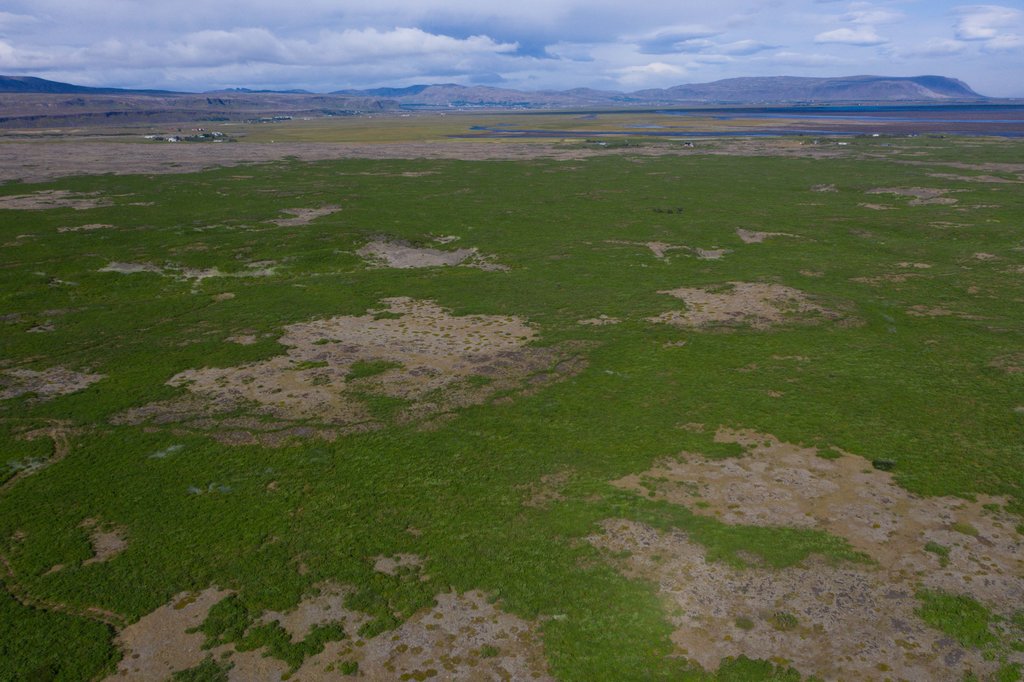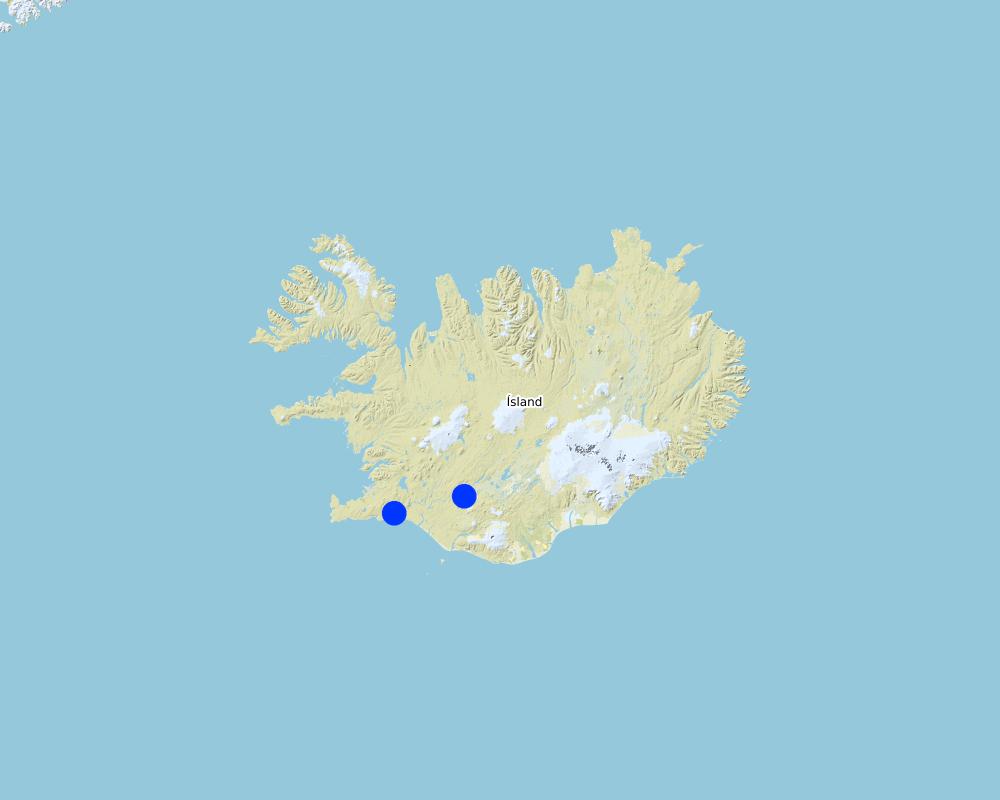Seeding lupine for land reclamation and to protect the soil against wind erosion [冰岛]
- 创建:
- 更新:
- 编制者: Jan Reichert
- 编辑者: Hanspeter Liniger
- 审查者: Hanspeter Liniger
Nootka lupine or Alaska lupine
technologies_5750 - 冰岛
查看章节
全部展开 全部收起1. 一般信息
1.2 参与该技术评估和文件编制的资源人员和机构的联系方式
关键资源人
SLM专业人员:
Runólfsson Sveinn
Soil Conservation Service of Iceland
冰岛
1.3 关于使用通过WOCAT记录的数据的条件
编制者和关键资源人员接受有关使用通过WOCAT记录数据的条件。:
是
2. SLM技术的说明
2.1 技术简介
技术定义:
The nootka lupine is sown in sandy and gravelly areas to increase the vegetation cover and fertilize the soil.
2.2 技术的详细说明
说明:
The nootka lupine (Lupinus nootkatensis) is a legume that can survive in the harsh climate of Iceland. It was introduced from Alaska to increase the soil cover and fertilise the sandy and gravelly soil. For that purpose, it has been widely used after 1990 all over Iceland. Because of the large amount of seed production, the plant is able to reproduce itself quickly and independently. An increased vegetation cover causes that the vulnerability to wind erosion is minimized. The ground is protected and sandstorms can be reduced. The ability of the lupine to store nitrogen through its root system reduces the use of fertilizer. Especially when planting trees, fertilizer can be saved. The lupine is mostly sown with seed drills and tractors. Planting of lupine is an extremely cost-efficient and effective way of increasing soil cover and soil fertility. It is a unique application. No further operations need to be carried out after that.
However, the nootka lupin is very controversial in Iceland despite its advantages. The use of lupines should be carefully considered, especially in sensitive and protected areas. The non-native plant is very invasive and leads to the displacement of the native vegetation. Grazing does not stop lupines to spread, only young plants are eaten by sheep, but once mature, its bitterness renders it unpalatable. On a small scale, it is possible with great effort to slow down the spread by cutting the flowers. On a large scale, the spread can only be stopped with herbicides which is highly controversial. Due to its invasiveness, the Soil Conservation Service stopped using the lupine in 2018.
2.3 技术照片
2.5 已应用该技术的、本评估所涵盖的国家/地区/地点
国家:
冰岛
区域/州/省:
South of Iceland
有关地点的进一步说明:
Thorlákshöfn, Hekla area
具体说明该技术的分布:
- 均匀地分布在一个区域
如果不知道精确的区域,请注明大致覆盖的区域:
- 10-100 平方千米
Map
×2.6 实施日期
如果不知道确切的年份,请说明大概的日期:
- 10-50年前
2.7 技术介绍
详细说明该技术是如何引入的:
- 在实验/研究期间
- 通过项目/外部干预
3. SLM技术的分类
3.1 该技术的主要目的
- 减少、预防、恢复土地退化
- 降低灾害风险
3.2 应用该技术的当前土地利用类型
同一土地单元内混合使用的土地::
否

不毛之地
具体说明:
eroded land, degraded land
3.3 由于技术的实施,土地使用是否发生了变化?
由于技术的实施,土地使用是否发生了变化?:
- 否(继续问题3.4)

不毛之地
具体说明:
Lupine is to bitter for sheep. That's why the land can't be grazed.
3.4 供水
该技术所应用土地的供水:
- 雨养
3.5 该技术所属的SLM组
- 防风林/防护林带
- 改良的地面/植被覆盖
3.6 包含该技术的可持续土地管理措施

植物措施
- V2:草和多年生草本植物
注释:
Can be combined with birch tree planing
3.7 该技术强调的主要土地退化类型

土壤风蚀
- Et:表土流失
- Ed:风蚀风积
- Eo:场外劣化效应
3.8 防止、减少或恢复土地退化
具体数量名该技术与土地退化有关的目标:
- 修复/恢复严重退化的土地
4. 技术规范、实施活动、投入和成本
4.2 有关投入和成本计算的一般信息
具体说明成本和投入是如何计算的:
- 每个技术区域
注明尺寸和面积单位:
Project costs in Thorlákshöfn
具体说明成本计算所用货币:
- 美元
4.4 技术建立所需要的费用和投入
| 对投入进行具体说明 | 单位 | 数量 | 单位成本 | 每项投入的总成本 | 土地使用者承担的成本% | |
|---|---|---|---|---|---|---|
| 其它 | Seeding lupine | ha | 1.0 | 204.0 | 204.0 | |
| 技术建立所需总成本 | 204.0 | |||||
| 技术建立总成本,美元 | 204.0 | |||||
4.7 影响成本的最重要因素
描述影响成本的最决定性因素:
workers, seeds, machinery
5. 自然和人文环境
5.1 气候
年降雨量
- < 250毫米
- 251-500毫米
- 501-750毫米
- 751-1,000毫米
- 1,001-1,500毫米
- 1,501-2,000毫米
- 2,001-3,000毫米
- 3,001-4,000毫米
- > 4,000毫米
农业气候带
- 潮湿的
- 半湿润
5.2 地形
平均坡度:
- 水平(0-2%)
- 缓降(3-5%)
- 平缓(6-10%)
- 滚坡(11-15%)
- 崎岖(16-30%)
- 陡峭(31-60%)
- 非常陡峭(>60%)
地形:
- 高原/平原
- 山脊
- 山坡
- 山地斜坡
- 麓坡
- 谷底
垂直分布带:
- 0-100 m a.s.l.
- 101-500 m a.s.l.
- 501-1,000 m a.s.l.
- 1,001-1,500 m a.s.l.
- 1,501-2,000 m a.s.l.
- 2,001-2,500 m a.s.l.
- 2,501-3,000 m a.s.l.
- 3,001-4,000 m a.s.l.
- > 4,000 m a.s.l.
说明该技术是否专门应用于:
- 不相关
5.3 土壤
平均土层深度:
- 非常浅(0-20厘米)
- 浅(21-50厘米)
- 中等深度(51-80厘米)
- 深(81-120厘米)
- 非常深(> 120厘米)
土壤质地(表土):
- 粗粒/轻(砂质)
土壤质地(地表以下> 20厘米):
- 粗粒/轻(砂质)
5.4 水资源可用性和质量
地下水位表:
< 5米
地表水的可用性:
中等
水质(未处理):
良好饮用水
水质请参考::
地下水
5.5 生物多样性
物种多样性:
- 中等
栖息地多样性:
- 低
5.6 应用该技术的土地使用者的特征
定栖或游牧:
- 定栖的
相对财富水平:
- 丰富
个人或集体:
- 团体/社区
- 员工(公司、政府)
机械化水平:
- 机械化/电动
性别:
- 女人
- 男人
5.7 应用该技术的土地使用者使用的平均土地面积
- < 0.5 公顷
- 0.5-1 公顷
- 1-2 公顷
- 2-5公顷
- 5-15公顷
- 15-50公顷
- 50-100公顷
- 100-500公顷
- 500-1,000公顷
- 1,000-10,000公顷
- > 10,000公顷
这被认为是小规模、中规模还是大规模的(参照当地实际情况)?:
- 中等规模的
5.8 土地所有权、土地使用权和水使用权
土地所有权:
- 州
- 社区/村庄
土地使用权:
- 个人
用水权:
- 个人
5.9 进入服务和基础设施的通道
健康:
- 贫瘠
- 适度的
- 好
教育:
- 贫瘠
- 适度的
- 好
技术援助:
- 贫瘠
- 适度的
- 好
就业(例如非农):
- 贫瘠
- 适度的
- 好
市场:
- 贫瘠
- 适度的
- 好
能源:
- 贫瘠
- 适度的
- 好
道路和交通:
- 贫瘠
- 适度的
- 好
饮用水和卫生设施:
- 贫瘠
- 适度的
- 好
金融服务:
- 贫瘠
- 适度的
- 好
6. 影响和结论性说明
6.1 该技术的现场影响
社会经济效应
水资源可用性和质量
饮用水的可用性
饮用水的质量
社会文化影响
健康状况
注释/具体说明:
Less sediment in the air during windstorms due to increased ground cover and therefore fewer health consequences.
文化机会
娱乐机会
社区机构
国家机构
SLM/土地退化知识
生态影响
水循环/径流
水量
水质
水的回收/收集
地表径流
地下水位/含水层
蒸发
土壤
土壤水分
土壤覆盖层
土壤流失
养分循环/补给
生物多样性:植被、动物
植被覆盖
生物量/地上C
植物多样性
注释/具体说明:
Due to its invasiveness and its enormously dense growth, other native plants are displaced by the lupine.
栖息地多样性
注释/具体说明:
Due to its invasiveness and its enormously dense growth, other native plants are displaced by the lupine.
减少气候和灾害风险
碳和温室气体的排放
风速
6.2 该技术的场外影响已经显现
水资源可用性
下游洪水
下游淤积
地下水/河流污染
缓冲/过滤能力
风力搬运沉积物
对邻近农田的破坏
对公共/私人基础设施的破坏
温室气体的影响
6.3 技术对渐变气候以及与气候相关的极端情况/灾害的暴露和敏感性(土地使用者认为的极端情况/灾害)
气候有关的极端情况(灾害)
生物灾害
| 该技术是如何应对的? | |
|---|---|
| 昆虫/蠕虫侵扰 | 适度 |
注释:
The lupine has been infested by a larvae in recent years. However, its population has collapsed and thus shrunk considerably.
6.4 成本效益分析
技术收益与技术建立成本相比如何(从土地使用者的角度看)?
短期回报:
积极
长期回报:
积极
技术收益与技术维护成本/经常性成本相比如何(从土地使用者的角度看)?
短期回报:
积极
长期回报:
积极
6.5 技术采用
- 11-50%
6.6 适应
最近是否对该技术进行了修改以适应不断变化的条件?:
是
其它(具体说明):
stopp further seeding
具体说明技术的适应性(设计、材料/品种等):
Due to its invasiveness in Iceland, the Soil Conservation Service of Iceland stopped using the lupine in 2018.
6.7 该技术的优点/长处/机会
| 土地使用者眼中的长处/优势/机会 |
|---|
| The use of lupines is a very cost-effective application, which protects the soil well against wind erosion. |
| 编制者或其他关键资源人员认为的长处/优势/机会 |
|---|
| The use of lupines is a very cost-effective application, which protects the soil well against wind erosion. |
| Less artificial fertiliser has to be used because the lupine fertilizes the soil. |
| Sowing the lupine is a unique application. No further operations need to be carried out after that. |
6.8 技术的弱点/缺点/风险及其克服方法
| 土地使用者认为的弱点/缺点/风险 | 如何克服它们? |
|---|---|
| Lupine is very invasive and displaces native plants. | The use of lupines should be carefully considered. On a small scale, it is possible with great effort to slow down the spread by cutting the flowers. On a large scale, the only possibility to stop the spreading would be the use of herbicides. |
| The aesthetic value of the landscape is reduced by the monoculture of lupines. | By planting trees in the lupines the aesthetic value can be increased. |
| 编制者或其他关键资源人员认为的弱点/缺点/风险 | 如何克服它们? |
|---|---|
| The non-native plant is very invasive and produces large quantities of seeds why it is spreading rapidly. This leads to the displacement of the native vegetation. This can become a significant problem in protected areas (national parks). | The use of lupines should be carefully considered, especially in sensitive and protected areas. On a small scale, it is possible with great effort to slow down the spread by cutting the flowers. On a large scale, the only possibility to stop the spreading would be the use of herbicides. |
7. 参考和链接
7.1 信息的方法/来源
- 实地考察、实地调查
- 与土地使用者的访谈
- 与SLM专业人员/专家的访谈
(现场)数据是什么时候汇编的?:
01/08/2019
7.3 链接到网络上的相关信息
标题/说明:
Webpage Soil Conservation Service of Iceland
URL:
https://land.is/english/
链接和模块
全部展开 全部收起链接
无链接
模块
无模块





